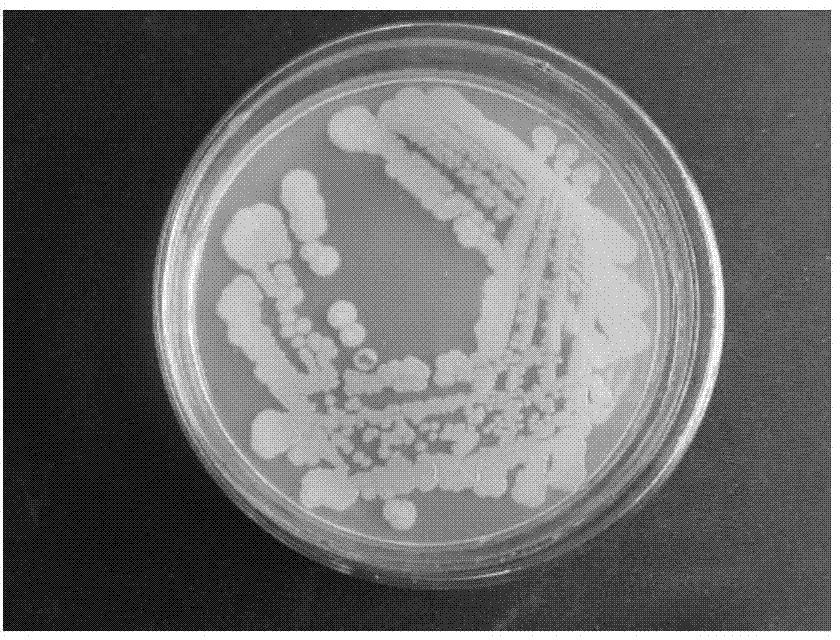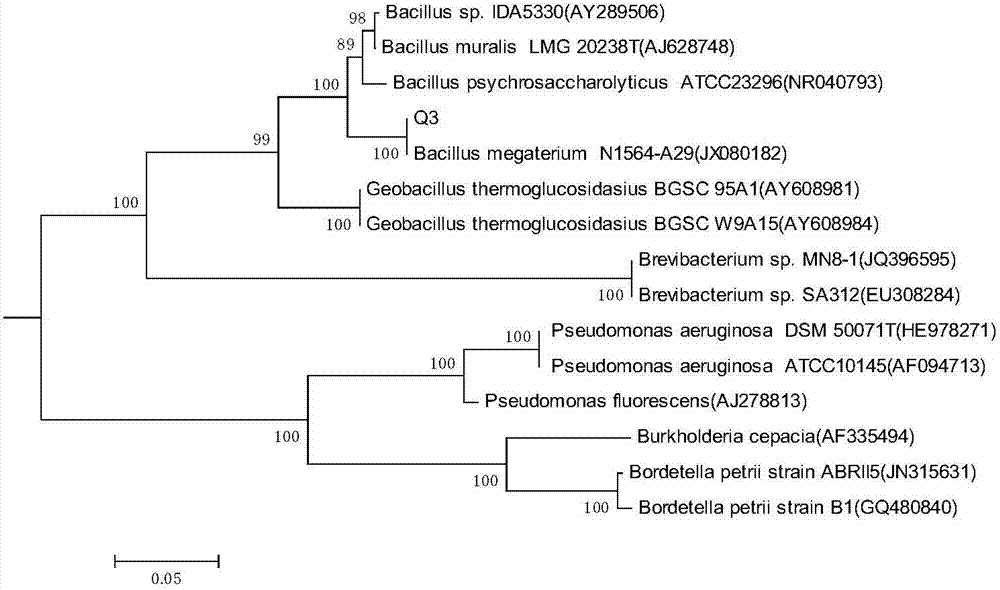Endogenous bacillus megatherium and applications thereof in restoration of quinclorac phytotoxicity
A technology of Bacillus megaterium and quinclorac, which is applied in the field of pesticide-contaminated microorganism restoration, can solve the problems of slow degradation, damage to growth, damage to sensitive crops in subsequent stubble, etc., and achieves the effects of reducing production loss and improving yield and quality.
- Summary
- Abstract
- Description
- Claims
- Application Information
AI Technical Summary
Problems solved by technology
Method used
Image
Examples
Embodiment 1
[0027] The isolation and identification of embodiment 1 bacterial strain
[0028] The present invention adopts the plate marking method to obtain an endogenous degrading bacterium Q3 that has a better degradation effect to quinclorac from the root system of tobacco damaged by quinclorac, and the Q3 colony morphology and scanning electron microscope photos are as follows: figure 1 , figure 2 shown.
[0029] 1. Culture medium:
[0030] Inorganic salt culture medium: 1 g of ammonium sulfate, 2 g of potassium dihydrogen phosphate, 0.5 g of magnesium sulfate, 0.1 g of sodium chloride, 0.5 g of calcium carbonate, 1000 ml of deionized water, pH 7.0, autoclaved at 121°C for 30 min.
[0031] LB medium: beef extract 10g, peptone 5g, sodium chloride 10g (solid medium plus agar 15g), 1000mL deionized water, pH 7.0, autoclaved at 121°C for 30min.
[0032] 2. Isolation and purification of endogenous degrading bacteria
[0033] Take the root system of tobacco injured by quinclorac, rins...
Embodiment 2
[0044] Research on the degradation characteristics of embodiment 2 degrading bacteria Q3
[0045] The influence of medium pH on the growth and degradation rate of degrading bacteria Q3: prepare inorganic salt medium (adding a small amount of sucrose and yeast powder as additional carbon source) and divide them into Erlenmeyer flasks, and fill each bottle with 50ml of medium, adjust the medium The pH value is respectively 5, 6, 7, 8, 9 (each processing 3 repetitions), adds quinclorac after the sterilization treatment, makes the concentration of quinclorac in each Erlenmeyer flask be 20mg / L, Then insert the activated degrading bacteria Q3 bacterium solution with an inoculation amount of 5% (volume fraction), put it into 30 ℃, 180r min -1 Shaking culture in a constant temperature shaker. After 7 days, samples were taken to measure the OD 600 value and degradation rate.
[0046] The influence of culture temperature on the growth and degradation rate of degrading bacteria Q3: th...
Embodiment 3
[0051] The control effect of embodiment 3 bacterial strain Q3 to tobacco injury
[0052] Take K326 as the test tobacco. The preserved Q3 strain was transferred to sterilized liquid LB medium, and cultured in the dark at 30°C and 180r / min constant temperature shaker overnight.
[0053] Get the soil with the recommended dose of quinclorac in the previous paddy field, air-dry and pulverize it, and put it into pots with a diameter of 18 cm and a height of 20 cm, and each pot is filled with 3 kg of soil. 7d before transplanting tobacco seedlings, use Q3 fermentation broth (Q3 was cultured and fermented overnight, OD 600 =0.63, after diluting 10ml fermented liquid of every plant with 200ml water, evenly apply it to pots and bowls. ) for soil treatment. Set up the blank control group (cultivation in soil without quinclorac residues, no phytotoxicity), the phytotoxicity control group (soil with quinclorac residues, no degrading bacteria treatment) and the treatment group (10ml of Q...
PUM
| Property | Measurement | Unit |
|---|---|---|
| Concentration | aaaaa | aaaaa |
Abstract
Description
Claims
Application Information
 Login to View More
Login to View More - R&D
- Intellectual Property
- Life Sciences
- Materials
- Tech Scout
- Unparalleled Data Quality
- Higher Quality Content
- 60% Fewer Hallucinations
Browse by: Latest US Patents, China's latest patents, Technical Efficacy Thesaurus, Application Domain, Technology Topic, Popular Technical Reports.
© 2025 PatSnap. All rights reserved.Legal|Privacy policy|Modern Slavery Act Transparency Statement|Sitemap|About US| Contact US: help@patsnap.com



